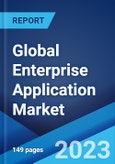The global enterprise application market size reached US$ 272.9 Billion in 2022. Looking forward, the market is expected to reach US$ 433.1 Billion by 2028, exhibiting a growth rate (CAGR) of 8.00% during 2022-2028.
Enterprise applications include digital and content creation, communication and collaboration software, customer relationship management (CRM), and enterprise resource planning (ERP). They are scalable, component-based, data-centric, and user-friendly. They are used to integrate core business processes, such as sales, finance, accounting, inventory, human resources, and manufacturing, on a single server architecture in real-time. They provide the advantages of office suites, project and portfolio management, and supply chain management (SCM). Consequently, they are deployed in corporate networks to automate business processes with large amounts of complex data and connect enterprises with suppliers, commercial entities, and customers across the globe.
Enterprise applications include digital and content creation, communication and collaboration software, customer relationship management (CRM), and enterprise resource planning (ERP). They are scalable, component-based, data-centric, and user-friendly. They are used to integrate core business processes, such as sales, finance, accounting, inventory, human resources, and manufacturing, on a single server architecture in real-time. They provide the advantages of office suites, project and portfolio management, and supply chain management (SCM). Consequently, they are deployed in corporate networks to automate business processes with large amounts of complex data and connect enterprises with suppliers, commercial entities, and customers across the globe.
Enterprise Application Market Trends
Due to the expansion of business globally, enterprises are facing challenges in managing large amounts of data. This represents one of the key factors driving the adoption of enterprise applications worldwide as they provide enhanced collaboration, improved efficiency, reduced risk, connected data, and real-time insights to build a smart business. Moreover, they are employed in the banking, financial services, and insurance (BFSI) sector to make a balanced financial structure and hire qualified talent. Apart from this, the integration of technologies like artificial intelligence (AI), the internet of things (IoT), and edge computing are providing agility to make critical decisions, optimize investments to fund innovation, and deliver essential customer experiences. This is further expanding the usage of enterprise applications in various end use industries. Furthermore, due to the growing focus on rapid innovation and continuation, organizations are deploying and managing ERP software across hybrid cloud solutions, which, in turn, is catalyzing the demand for enterprise applications around the world. Additionally, several vendors are providing customization options to upgrade various features of enterprise applications, which is anticipated to impel the growth of the market.Key Market Segmentation
This research provides an analysis of the key trends in each sub-segment of the global enterprise application market report, along with forecasts at the global, regional and country level from 2023-2028. The report has categorized the market based on solution, organization size, deployment mode and end user.Breakup by Solution:
- Customer Relationship Management
- Enterprise Resource Planning
- Supply Chain Management
- Analytics and Business Intelligence
- Human Capital Management
- Productivity Tools
Breakup by Organization Size:
- Small and Medium Enterprises
- Large Enterprises
Breakup by Deployment Mode:
- On-premises
- Cloud-based
Breakup by End User:
- BFSI
- Manufacturing and Retail
- Healthcare and Pharmaceuticals
- IT and Telecommunication
- Government
Breakup by Region:
- North America
- United States
- Canada
- Asia-Pacific
- China
- Japan
- India
- South Korea
- Australia
- Indonesia
- Europe
- Germany
- France
- United Kingdom
- Italy
- Spain
- Russia
- Latin America
- Brazil
- Mexico
- Middle East and Africa
Competitive Landscape
The competitive landscape of the industry has also been examined along with the profiles of the key players being Accenture plc, Fujitsu Limited, Infosys Limited, International Business Machines Corporation, iTransition Group, Microsoft Corporation, Oracle Corporation, Pegasystems Inc., Salesforce.com Inc., SAP SE, Software AG and Tata Consultancy Services Limited.Key Questions Answered in This Report:
- How has the global enterprise application market performed so far and how will it perform in the coming years?
- What has been the impact of COVID-19 on the global enterprise application market?
- What are the key regional markets?
- What is the breakup of the market based on the solution?
- What is the breakup of the market based on the organization size?
- What is the breakup of the market based on the deployment mode?
- What is the breakup of the market based on the end user?
- What are the various stages in the value chain of the industry?
- What are the key driving factors and challenges in the industry?
- What is the structure of the global enterprise application market and who are the key players?
- What is the degree of competition in the industry?
Table of Contents
1 Preface3 Executive Summary12 Value Chain Analysis14 Price Analysis
2 Scope and Methodology
4 Introduction
5 Global Enterprise Application Market
6 Market Breakup by Solution
7 Market Breakup by Organization Size
8 Market Breakup by Deployment Mode
9 Market Breakup by End User
10 Market Breakup by Region
11 SWOT Analysis
13 Porters Five Forces Analysis
15 Competitive Landscape
Companies Mentioned
- Accenture plc
- Fujitsu Limited
- Infosys Limited
- International Business Machines Corporation
- iTransition Group
- Microsoft Corporation
- Oracle Corporation
- Pegasystems Inc.
- Salesforce.com Inc.
- SAP SE
- Software AG
- Tata Consultancy Services Limited
Methodology

LOADING...
Table Information
| Report Attribute | Details |
|---|---|
| No. of Pages | 149 |
| Published | November 2023 |
| Forecast Period | 2022 - 2028 |
| Estimated Market Value ( USD | $ 272.9 Billion |
| Forecasted Market Value ( USD | $ 433.1 Billion |
| Compound Annual Growth Rate | 8.0% |
| Regions Covered | Global |
| No. of Companies Mentioned | 12 |









